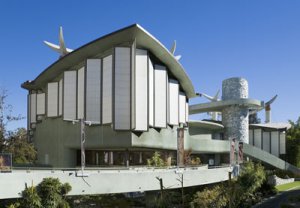"The striking thing about seeing this pavilion in real life is that its strangeness... is not so overwhelming. The real building comes off less as odd than as endearing, almost sweet."
That's Paul Goldberger's New York Times review of our Pavilion for Japanese Art upon its unveiling in 1988—September 25, to be exact. Twenty years last week. It is a somewhat bizarre building, so I took the occasion of its anniversary to ask Rob Singer, founding curator and department head of Japanese Art at LACMA, to share a few details.
First, the roof, with those swooping, birdlike sculptural elements that look to be tied down by cables, as if they might fly away. Actually, the cables aren't holding anything down—they're holding the roof up, connected to the six massive columns rising through the building. "In traditional Japanese architecture," Rob told me, "the walls are non-loadbearing." In other words, if you were to peel the walls away like a banana, the roof would still be hanging over your head.
The stones encrusting the two towers (one a stairwell, the other an elevator shaft) and other elements around the building are quartzite. This may be apocryphal, according to Rob, but the quartzite was discovered in a "lost" mine in Utah, which has since been re-lost.
And finally, the light: the artwork inside is illuminated almost entirely by natural light, filtered through exterior panels. Rob says he's been asked numerous times by Japanese visitors how often we have to change the paper, but in fact they are a kind of fiberglass called Kalwall, which filters out UV rays and refracts incoming sunlight into a balanced light. Rob described when a Catholic cardinal toured the pavilion: "As we entered the galleries, he turned to me and said 'That's it! This is the quality of light I've been looking for! It's perfect for a chapel.' The pavilion was an epiphany for him."




